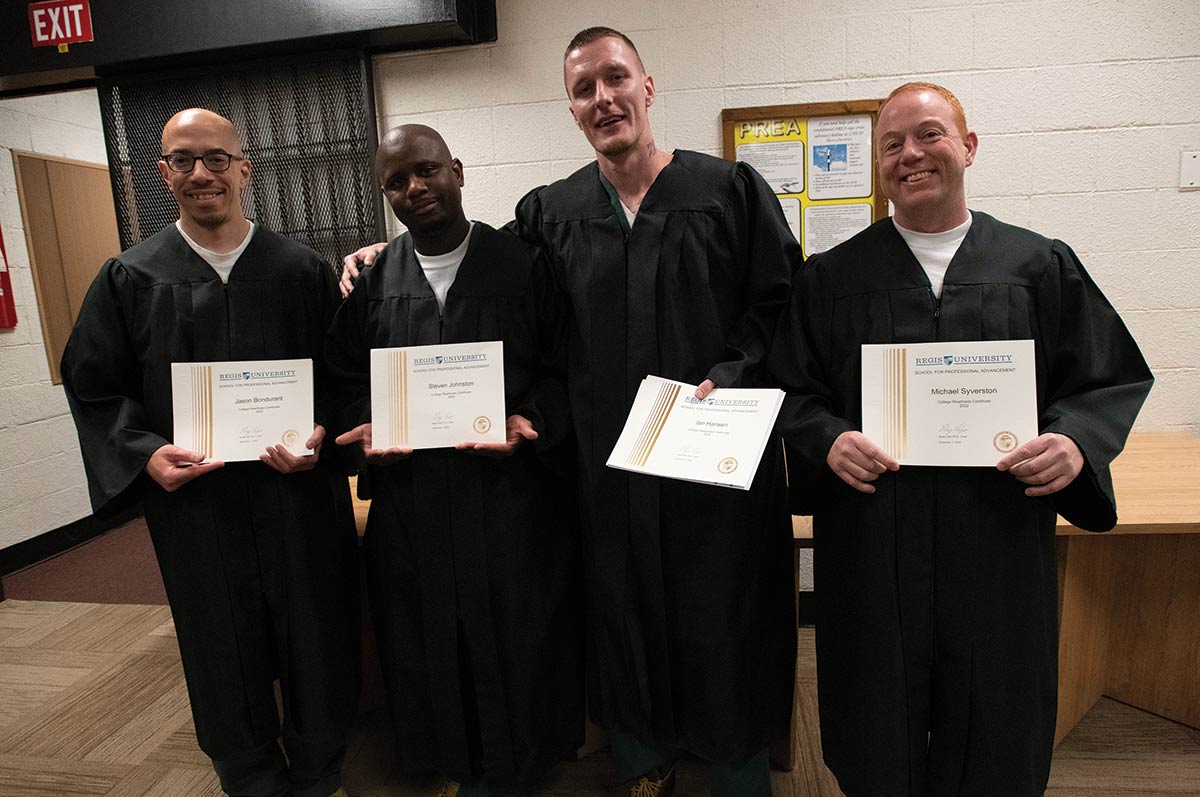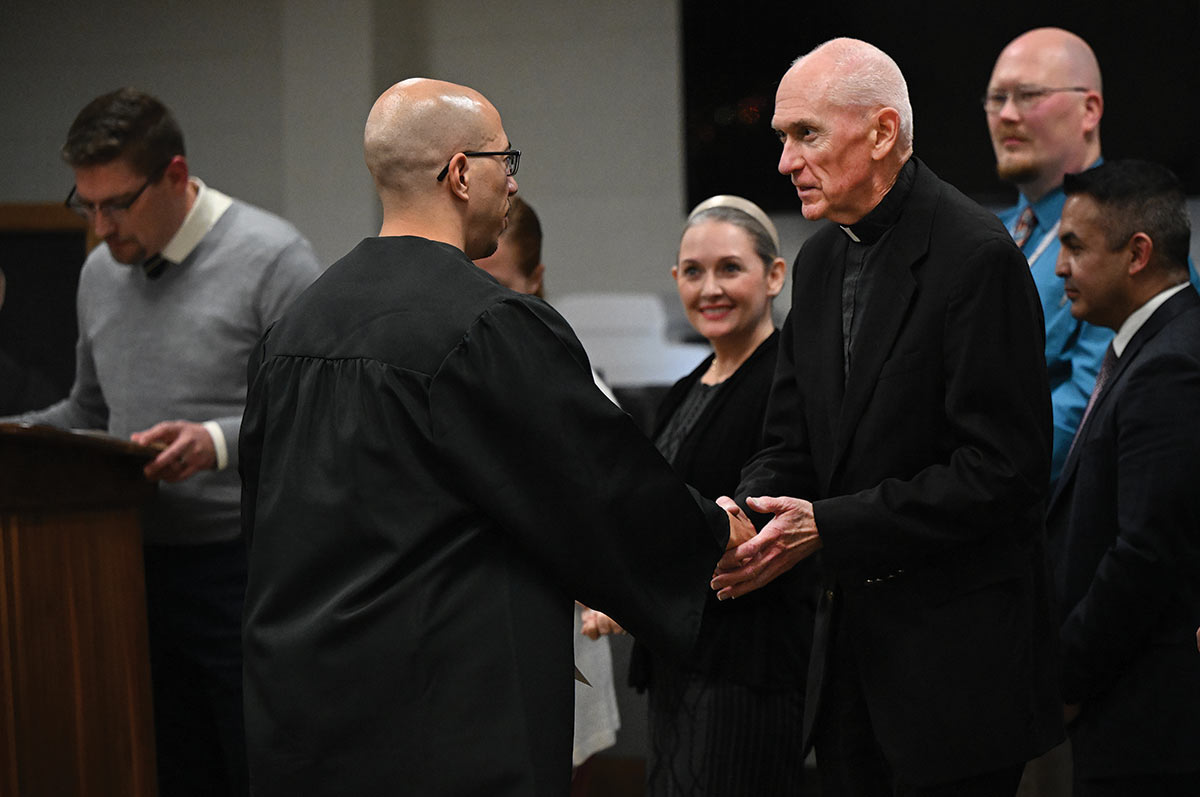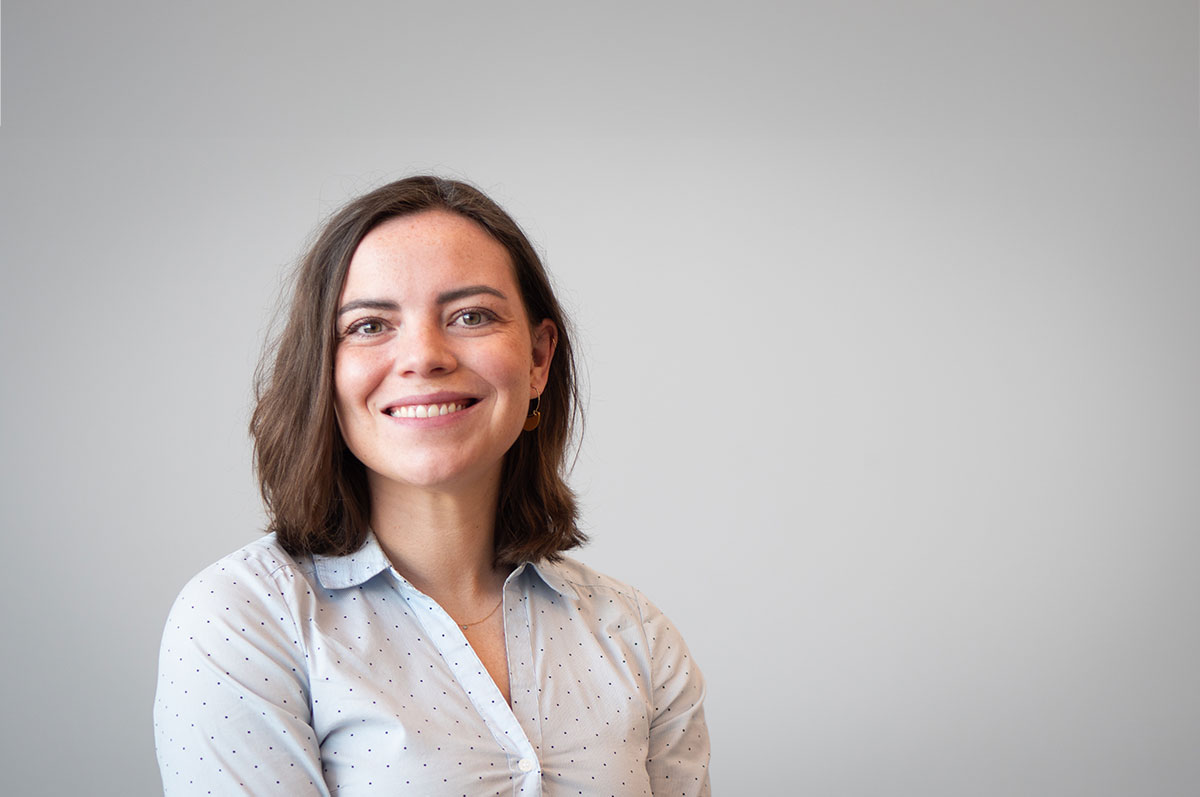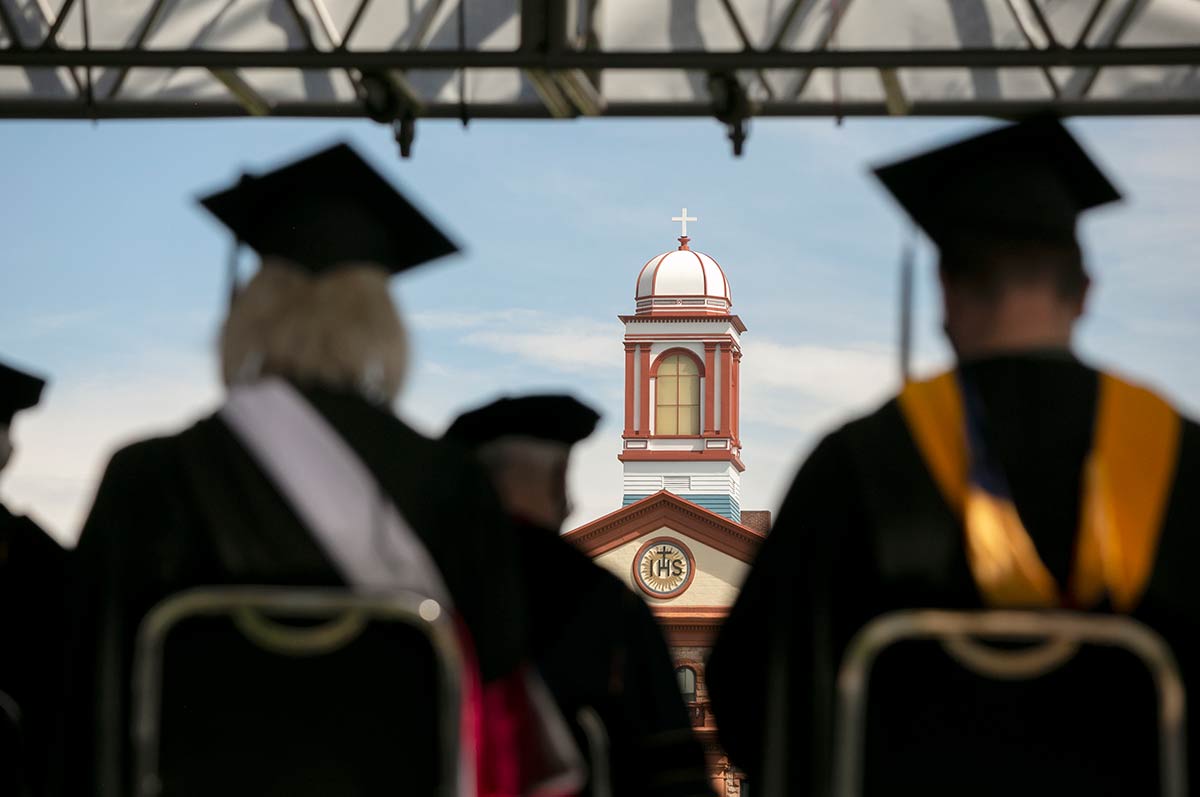Education Unbarred
Regis prison education provides transformation and insight to those on the inside – and the outside
“Due to a multitude of poor life choices, at the age of twenty-five, I was arrested and incarcerated...Taking full responsibility for my life and holding myself accountable to do the work necessary for success is my top priority...I am applying for enrollment to Regis because a formal education will support my goal of being of service to my community…”
That excerpt is not from a typical college application essay.
But Jason Bondurant — Jay to those who know him — isn’t your typical college student. Inside the clattering, clanging halls of Colorado Territorial Correction Facility in Cañon City, Colo., Bondurant is what’s known as “life without.” That’s shorthand for the sentence handed down to him in 2007: Life without the possibility of parole.
Nevertheless, Bondurant got accepted to college. In 2022, he became one of the first incarcerated students enrolled in Regis University’s Virtual Inside/Out program. Launched by the University’s School for Professional Advancement (SPA) in cooperation with the Colorado Department of Corrections (DOC), the program offers five liberal arts courses, one at a time, in eight-week terms, to up to 20 incarcerated men and women at four Colorado prisons. All must be approved for participation by prison officials.
Through internet access and laptops provided to them, the incarcerated students learn simultaneously with, though not alongside, students who attend the classes in person on the northwest Denver campus. Regis students are the “out” portion of the Inside/Out program.
Bryan Hall, Ph.D., dean of SPA and a philosophy professor, said the program benefits Regis students as well as incarcerated people. Both gain insight from the different perspectives and lived experiences of classmates they encounter on the other side of computer screens, he said. Virtually mingling incarcerated and non-incarcerated students “creates a radically diverse and powerful learning experience” for both groups, he said.
“Programs like this do a lot to promote human dignity and transform the people who go into them,” Hall said.
Though the number of people in prisons and local jails in the United States declined in 2019 to just under 2.1 million according to the U.S. Department of Justice (DOJ) Bureau of Justice Statistics, the country’s rate of 810 prison or jail inmates for every 100,000 adults remains the world’s highest.
It’s important to remember, however, that “Ninety-five percent of those individuals will return to the community,” said Moses “Andre” Stancil, executive director of the Colorado Department of Corrections, and a two-time Regis graduate.
“If the system is such that we isolate them from community partners and community involvement and then we just release them back into the community, just think about how devastating that can be. For them, and for the community,” said Stancil, who earned a bachelor’s degree in behavioral science from Regis in 2002, and a master’s in criminal justice in 2009.
Life after release often doesn’t go well. The federal Bureau of Justice Statistics (BJS) tracked 50,500 people released from federal prisons in 2010. Of those, more than one-third had not found a job four years after being released. For those without a prison record, the overall unemployment rate in 2010 was 9.6 percent. It’s no wonder then, that, according to the RAND Corp., more than half of those released return to prison within three years.
“We don’t rehabilitate people in this country,” said Rev. Thomas Curran, S.J., of the St. Peter Faber Jesuit Community at Regis. “We incarcerate. We warehouse. Then we hope that when someone is released, they desist in committing a crime.”
The national debate over the goal of prison — to punish or to rehabilitate — likely won’t be settled anytime soon. But on his watch, Stancil has made it clear the matter is not up for discussion. “With every new class of staff, the main point I make is, ‘If you took this job because you believe you are here to punish people, take your things and leave now,’” he said. “We’re here to focus on providing the resources to return them to the community as better citizens.”
There are a few staff within the state’s prisons who grumble about providing free education to offenders, Stancil said, but most see the benefits for everyone involved.
Stancil doesn’t need research to confirm that. “From my 30 years working in prisons, I know that when an incarcerated individual is busy, it’s a safer environment for staff, and for the incarcerated individuals.” As every parent knows, Stancil said, when people have lots of idle time, they can fill it with positive activities, or not-so-positive activities.

Inside/Out’s incarcerated students come to class with an assortment of educational backgrounds. A few have taken college classes, often in prison. Many have a high-school equivalency certification. Some have neither. Nationwide, a majority of those serving time – 64 percent – have high school diplomas, according to a 2019 study by the Vera Institute of the Georgetown Center on Poverty and Inequality. The other side of the coin, of course, is that 30 percent of incarcerated people have not graduated from high school — a rate more than twice that of Americans walking around outside prison walls.
Whatever background they bring, Assistant Communications Prof. April Samaras makes sure all her students — both inside and out — leave her class equipped to learn at the college level. In Communications 212: The Skilled Learner, she guides them in learning how to study, how to craft an essay, how to keep a journal. How to think. Woven through it all is Regis’ guiding value, Cura Personalis. For many, especially those inside, the concept of care for the whole person isn’t one they have experience with, she said.
“We do a lot of reflective journal writing, talking about where they are, where they want to be,” Samaras said. She asks them to write to their younger selves and to describe what they might do differently, given the chance.
The results can be almost as rewarding for the instructor as for the students. “Many of them step into an uncomfortable space and really open up,” Samaras said. The class “gives them a safe space and a place to imagine opportunities.”
Regis instructors don’t receive additional pay for Inside/Out teaching, but the hours do count toward their contractual obligation, Hall said.
Last December, the first group of Inside/Out students to complete their classwork put on mortar boards and graduation gowns and collected the Certificate of College Readiness during a ceremony at the Colorado Territorial Correction Facility in Cañon City. Jason Bondurant spoke at that ceremony.
As the Cañon City Daily Record reported, Bondurant referenced the dark green scrubs that are his daily prison uniform when he said, “I wear these clothes that represent the worst day of my life.” But the graduation gown he wore that day represented potential, and hope. “This is who we have become,” he said.
That worst day was Aug. 25, 2005. Bondurant had gone to the home the mother of his three young sons shared with her mother and father, hoping, he later said, to see his boys. There was a confrontation, and Bondurant shot and killed the stepbrother of his former girlfriend and a man Bondurant believed she was seeing.
Should the loved ones of those dead men question the investment of resources and care in Bondurant, who is serving a life sentence, Curran said he would answer simply that the prison work is about “a conversion of humanity. We don’t help ourselves by saying ‘I’m not going to see that person as a human.’ In doing that we diminish our own humanity. Let’s make a collective effort to make sure this doesn’t happen to another family.”
The Inside/Out program may be new, but Curran, who now is involved with that program, is a veteran of prison education efforts. As president of Rockhurst University, he launched a partnership with the Missouri Department of Corrections to provide educational opportunities for incarcerated women and staff at the Chillicothe Correctional Center, an all-female facility northeast of Kansas City, Mo. He is presently coordinator of the Jesuit Prison Education Network (JPEN), which currently includes six colleges and universities.
“My goal is to get all 28 [Jesuit universities] to adopt a prison,” Curran said. The network can take steps toward that goal with its $290,000 share, over three years, of a $1.2 million grant from the Jesuit Social Research Institute.

We don’t rehabilitate people in this country. We incarcerate. We warehouse. Then we hope that when someone is released, they desist in committing a crime.
-Rev. Thomas Curran, S.J.
The money will go toward prison education necessities like technology, teacher pay and administration costs. It won’t fully cover those costs, which is why Curran and Hall say it is important to start small when it comes to education programs.
For 26 years, incarcerated students were barred from receiving federal financial aid, known as Pell Grants, to help pay for their education. During the ban, enacted in the early 1990s during a frenzy of “get tough on crime policies,” the number of prison education programs in the country shrank from 772 at the beginning of that decade to eight in 1997, according to a Vera Institute study.
In 2020, Congress reversed the ban, a move the Association of Jesuit Colleges and Universities advocated. Hall said full reinstatement of the grants is expected by July, and Inside/Out is applying for a share of those funds.
Jesuits trace the tradition of educating the incarcerated to St. Ignatius, who was himself imprisoned. One of Ignatius’ alleged crimes was preaching without the proper credentials — in other words, potential heresy. “During his imprisonment he realized education and credentials would give him greater authority,” Curran said.
Prison education worked for St. Ignatius, and it seems to work for the less divine as well. Individuals who participate in post-secondary education programs in prison are 48 percent less likely to be sent back to prison than those who don’t, according to a study published in the Journal of Experimental Criminology. They also are 12 percent more likely to get a job.
“It is hard to overstate the benefits of providing postsecondary education to incarcerated students,” according to the Brookings Institution authors of a 2021 study, “The Societal Benefits of Postsecondary Prison Education.”
There are quantifiable results of prison education. Then there are impacts that can’t be measured.
Jason Bondurant likely will never be released from prison. He won’t put what he learned in Inside/Out to work in a profession on the outside. Still, he has said, and Hall agrees, that education has meaning for incarcerated people like him.
“Jay feels like he has a role. That he’s been called to help those incarcerated not to come back.”
Stancil sees that with many individuals who know they likely will never see the outside of prison. “Believe it or not, a lot of our longterms are some of the best mentors,” he said. “They know they’re not going anywhere, and they have the greatest desire for a safe environment. And they deserve a safe environment.”
On his application for admission to the Inside/Out program, Bondurant stated he hoped to earn a degree in philosophy and apply that knowledge to his work in the prison’s restorative justice program.
And he concluded that essay by saying:
“Even though I am trapped in this world, condemned to push a stone up a mountain for eternity, I am happy. My effort is not futile…As Camus so eloquently states…‘The struggle itself toward heights is enough to fill a man’s heart.’”



